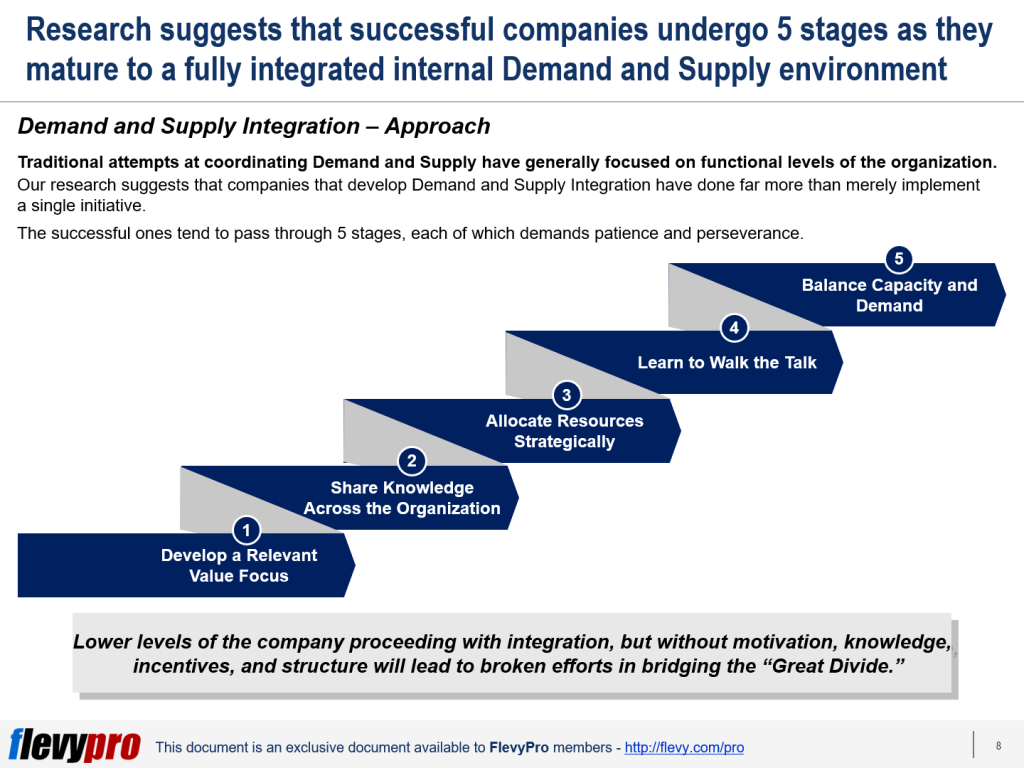Editor's Note: Take a look at our featured best practice, Digital Transformation Strategy (145-slide PowerPoint presentation). Digital Transformation is being embraced by organizations across most industries, as the role of technology shifts from being a business enabler to a business driver. This has only been accelerated by the COVID-19 global pandemic. Thus, to remain competitive and outcompete in today's fast paced, [read more]
* * * *
The “Great Divide” as referred to by Peter Drucker is the perennial issue of disconnect between Demand and Supply side within organizations.
Companies are trapped in a pattern of reacting to the whims of the marketplace without developing a proactively designed supply capacity. Curiously enough, such companies are often the victims of their own success — marketing programs that are not integrated with supply plans end up creating more demand than the company can fulfill. To create a more efficient and effective business model, companies must acknowledge that they need to integrate Demand and Supply Systems. This is an important concept of Supply Chain Management to understand and master.
Addressing The “Great Divide”
The disconnect between demand generation and supply fulfillment activities have made organizations suffer consequences of conflicting objectives and sub-optimal resource allocation. For example, discord between Sales and Production teams within an organization inevitably leads to sub-optimal resourcing decisions, customer dissatisfaction and loss of business opportunities.
 Studies conducted on successful organizations which bridged the gap between Supply and Demand side reveals the following underlying realities.
Studies conducted on successful organizations which bridged the gap between Supply and Demand side reveals the following underlying realities.
- Value requirements often vary significantly across customers or segments of choice, demanding cost efficiency in some cases and product and service differentiation in others.
- Unlike Sales, which has learned to tailor its offerings to the customer, the operational side of the enterprise is often incapable of altering its service proposition.
The 5 Stages of Successful Supply Demand Integration
Focused research and studies on the subject across various organizations through multiple industries, makes it evident that organizations which got their Supply and Demand successfully integrated goes to 5 stages.

Brief Outline
Stage 1: Develop a value focus – Senior leaders must cultivate a focus on creating value for the organization and for customers.
Stage 2: Share knowledge across the organization – Managers must work on building inter-functional collaboration within the company, building external collaboration with Supply Chain partners and adopting technology that facilitates collaboration.
Stage 3: Allocate resources strategically – Once the entire organization shares the same set of facts, the company can then begin to make more thoughtful analysis of where and where-not to allocate resources based on which customers deserve priority.
Stage 4: Learn to walk the talk – Executives at this stage make individuals accountable not just for their own unit’s performance but for the overall performance of the organization.
Case Example
Dell serves as an early example of successfully implemented Demand and Supply Integration.
In 1999, one customer (a leading author) ordered a computer three weeks before Christmas. It was a gift for his sons, and as such, he had a very specific time frame in which to receive it. So when he received a confirmation email stating that the computer would be ready on February 16, 2000, he replied that he needed the computer much earlier. A service representative researched the delay and explained that the 400 megahertz Pentium chip that he had ordered was particularly popular and, as a result, was backlogged. Rather than leaving a customer dissatisfied, the service rep suggested a way around the supply chain bottleneck. For an additional $50, Dell could upgrade the Pentium chip and ship the computer within a week. The author readily agreed, and the computer was received well before December 25.
The customer’s needs had been met, and at a price that was reasonable to him.
Interested in gaining more understanding of these 5 steps to successful Supply and Demand Integration? You can learn more and download an editable PowerPoint about Supply and Demand Integration here on the Flevy documents marketplace.
Are you a Management Consultant?
You can download this and hundreds of other consulting frameworks and consulting training guides from the FlevyPro library.

32-slide PowerPoint presentation
The Business Case is an instrumental tool in both justifying a project (requiring a capital budgeting decision), as well as measuring the project's success. The Business Case model typically takes the form of an Excel spreadsheet and quantifies the financial components of the project,
[read more]
Do You Want to Implement Business Best Practices?
You can download in-depth presentations on 100s of management topics from the FlevyPro Library. FlevyPro is trusted and utilized by 1000s of management consultants and corporate executives.
For even more best practices available on Flevy, have a look at our top 100 lists:
These best practices are of the same as those leveraged by top-tier management consulting firms, like McKinsey, BCG, Bain, and Accenture. Improve the growth and efficiency of your organization by utilizing these best practice frameworks, templates, and tools. Most were developed by seasoned executives and consultants with over 20+ years of experience.
Readers of This Article Are Interested in These Resources

103-slide PowerPoint presentation
Recent McKinsey research surveyed a large set of global executives and suggests that many companies, these days, are in a nearly permanent state of organizational flux. A rise in efforts in Organizational Design is attributed to the accelerating pace of structural change generated by market
[read more]

407-slide PowerPoint presentation
This is a very comprehensive document with over 400+ slides--covering 58 common management consulting frameworks and methodologies (listed below in alphabetical order). A detailed summary is provided for each business framework. The frameworks in this deck span across Corporate Strategy,
[read more]

41-slide PowerPoint presentation
The reality is: all businesses face the challenge of achieving sustainable Growth. They need viable Growth Strategies.
So, what is Growth Strategy?
It is the organization's high-level Corporate Strategy Plan that outlines everything the organization needs to do to achieve its goals for
[read more]

79-slide PowerPoint presentation
This document provides a holistic approach for undertaking strategic planning. While covering the traditional strategic planning approach, the document touches on adaptations that may be used in an unpredictable environment.
Contents:
1. Strategic Planning Overview
- Key questions and
[read more]






